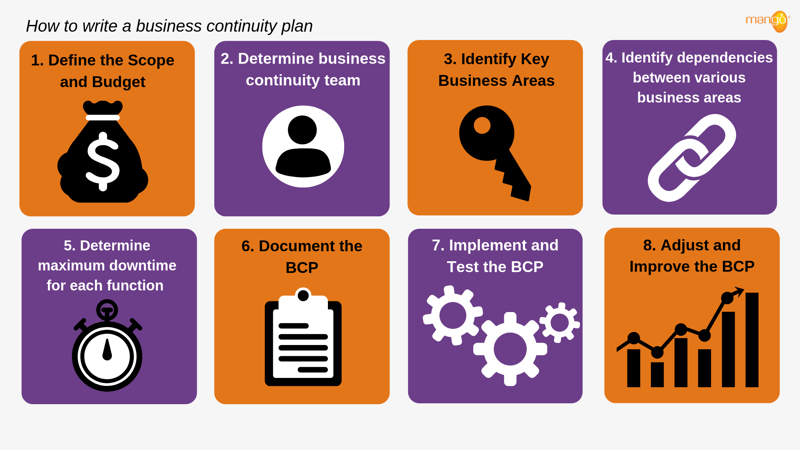How do you write a business continuity plan?
- Define the Scope and allocate budget
- Determine the business continuity team
- Identify key business areas
- Identify the dependencies between various business areas and functions
- Determine maximum allowed downtime for each function
- Document the plan
- Implement and test the plan
- Practice Adjust and improve the plan

1. Scope
Identifying the scope of the plan will require you to look at all aspects of your organisation and see what parts could be impacted by disruptions to your organisation.
During this stage, you need to consider the budget you have if a disaster or interruption was to occur in your organisation, and spread this accordingly. This may include costs of training employees on what to do in any event, services that may need to be used in the event of a disaster and processes that will help the plan progress.
2. Team
Determining the team composition will be a crucial part of the plan, as you have to assign managerial roles to various staff that they may need to step up to in the event of a disruption.
You need to identify the key roles, responsibilities and functions of your team members and use these to decide who should be responsible for what in the BCP. You need to clearly outline who is accountable for what and who has authority over other staff, so that there is no confusion when the plan needs to be put into action.
The number of people in tour team and the level of threat you are faced with will determine the size of your business continuity team. There is no set number of how many people will be involved.
Some of the key team members that will be involved in the BCP are:
- Executive manager or BCP Senior – This person is the highest leader of the business continuity committee and will communicate directly with top management and also people with less managerial roles than themselves.
- Program Coordinator (Team Leader) – This person is responsible for budgeting, implementing the plan and monitoring it where necessary. This employee will also be responsible for training others on how to act when the BCP is being used.
- Information Officer – This employee will have access to the data that can be used in the BCP, and has responsibility for making the BCP has a steady flow.
3. Key Business Areas
Identifying key business areas is crucial as these are the elements of your organisation that help it operate successfully.
When looking at these key areas of business, your organisation will be able to analyse the level to which each area will be impacted in the event of an interruption and then outline the consequences this will have on the whole organisation.
4. Dependencies
This step involves analysing the key business areas in relation to each other and determine what areas are dependent on each other for performance. For example, if you are running a manufacturing plant and you have a power outage, all of the machinery is likely going to be dependent on the operation of this.
5. Tolerable Downtime
This step involves analysing how long each key business area can be down for without impacting the overall functionality of the rest of the organisation.
This step will require you to prioritize specific tasks and make everyone aware of these, so that steps can be made to get the more crucial tasks or business areas up and running. When thinking about your budget, the areas that cannot be down for a long time without impacting the rest of the business will likely have the most budget and time allocated to mitigating them.
If you are unsure what business areas are more important than others, you can consider elements such as lost revenues or additional costs from pauses in operation, as well as the safety of your team.
6. Document
Once you have analysed all of the data and come up with a strategy that priorities certain tasks, it is time to document the BCP.
This step may take some time, as drafts will have to be made, and checked over with the rest of the team so that everyone agrees what is being done will be to the greatest benefit of your organisation.
Documenting the BCP is important so that all relevant employees can have access to it, as well as being able to show this to your auditor, or any external regulators.
7. Implement and test
This step is crucial as it is where the plan will be put into action as though an interruption has actually occurred within your organisation. This stage of the BCP will allow you to make alterations to the plan before finalizing it.
The only true way to know if your plan is going to work is to test it. More often than not, particular elements have been forgotten about when documenting the plan, which can be realised when it is actually trialed.
In order to test the plan, you can conduct drills, and exercises that involves the whole organisation.
8. Adjust and Improve
It is important that adjustments are frequently made to the BCP. If you ever get new resources that will have an impact on the plan, you must factor these into the plan and re-test it to ensure it will be effective.
As well as new resources, roles and responsibilities across the organisation may change, which needs to be accounted for in the adjustments.
BCP is an ongoing exercise that cannot just be done once and put to the side. It is important that you take these plans seriously so that your business can continue to operate effectively into the future in the event of a disaster or interruption.
Learn More:

